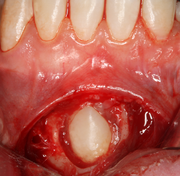An impacted tooth is one that fails to erupt into the dental arch within the expected developmental window. Because impacted teeth do not erupt, they are retained throughout the individual's lifetime unless extracted or exposed surgically. Teeth may become impacted because of adjacent teeth, dense overlying bone, excessive soft tissue or a genetic abnormality. Most often, the cause of impaction is inadequate arch length and space in which to erupt. That is the total length of the alveolar arch is smaller than the tooth arch (the combined mesiodistal width of each tooth). The wisdom teeth (third molars) are frequently impacted because they are the last teeth to erupt in the oral cavity. Mandibular third molars are more commonly impacted than their maxillary counterparts.
Some dentists believe that impacted teeth should be removed[1] This is often true for third molars causing various problems like pericoronitis, resorption of adjacent second molar etc. Other impacted teeth, especially canines or incisors, can be aligned with the rest of the dental arch by orthodontic treatment, thus regaining and retaining their mechanical and aesthetic function. In some cases, impacted teeth can be let sleeping inside the alveolus, but periodical check-ups are required for a possible pathological development. [2] Removal of asymptomatic, pathology-free, impacted teeth is not a medical consensus:[3][4] watchful monitoring may be a more prudent and cost-effective strategy[5][6][7] and make the future placement of a dental implant through such impacted tooth a feasible approach.[8]
- ^ Miloro M, Ghali GE, Larsen P, Waite P (2004). Peterson's Principles of Oral and Maxillofacial Surgery. Vol. 1. B C Decker. ISBN 9781550092349. Retrieved 2015-08-22.
- ^ "Impacted teeth including surgery for canine teeth". Cambridge University Hospitals. Cambridge, UK. Retrieved 2015-08-22.
- ^ "Wisdom tooth removal". The National Health Service. 24 October 2017.
- ^ Friedman JW (September 2007). "The prophylactic extraction of third molars: a public health hazard". American Journal of Public Health. 97 (9): 1554–1559. doi:10.2105/AJPH.2006.100271. PMC 1963310. PMID 17666691.
- ^ Ghaeminia H, Nienhuijs ME, Toedtling V, Perry J, Tummers M, Hoppenreijs TJ, et al. (May 2020). "Surgical removal versus retention for the management of asymptomatic disease-free impacted wisdom teeth". The Cochrane Database of Systematic Reviews. 2020 (5): CD003879. doi:10.1002/14651858.CD003879.pub5. PMC 7199383. PMID 32368796.
- ^ Anjrini AA, Kruger E, Tennant M (July 2015). "Cost effectiveness modelling of a 'watchful monitoring strategy' for impacted third molars vs prophylactic removal under GA: an Australian perspective". British Dental Journal. 219 (1): 19–23. doi:10.1038/sj.bdj.2015.529. PMID 26159980. S2CID 7178870.
- ^ Kandasamy S (July 2011). "Evaluation and management of asymptomatic third molars: Watchful monitoring is a low-risk alternative to extraction". American Journal of Orthodontics and Dentofacial Orthopedics. 140 (1): 11–17. doi:10.1016/j.ajodo.2011.05.008. PMID 21724081.
- ^ Mithridade D, Serge SM, Keyvan D, Nedjoua CO, Georgy D, Philippe R (January 2015). "Unconventional Implant Placement IV. Implant Placement through Impacted Teeth to Avoid Invasive Surgery. Long-term Results of 3 Cases". The Open Dentistry Journal. 9: 15–20. doi:10.2174/1874210601509010015. PMC 4319210. PMID 25674167.

